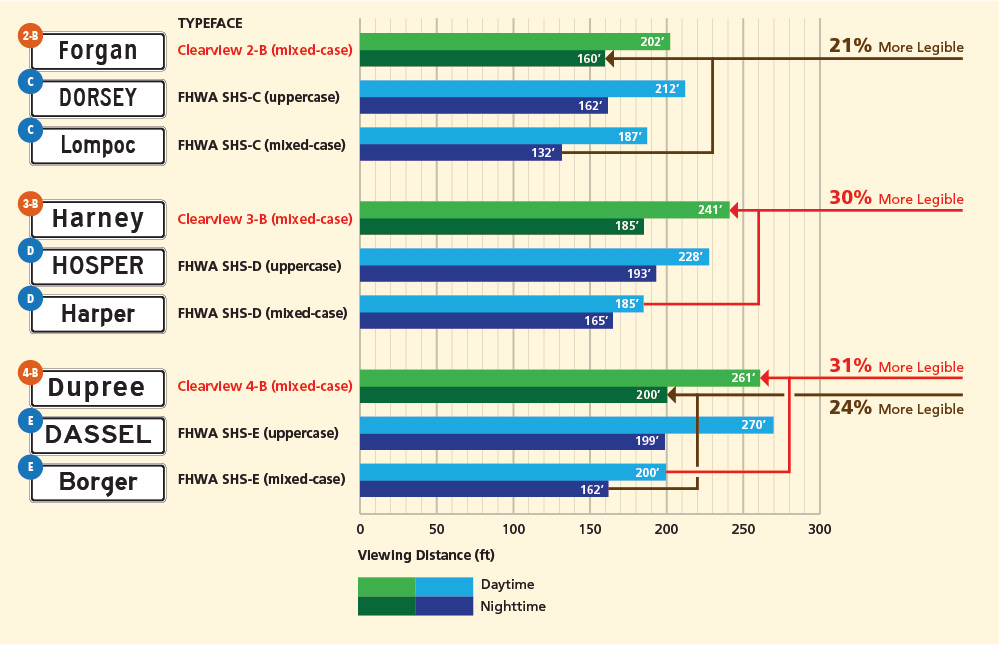3) Mid-weight font legibility: day and night
Mid-weights of Clearview out-perform FHWA mixed case.
The comparative typeface research leading up to the FHWA Interim Approval (IA-5) of Clearview in 2004 focused on the legibility and readability of guide signs. These are positive contrast applications with light (white) legends and darker contrasting background (green, brown and blue).
As the Clearview designs were finalized, studies after 2002 reflected the final upgrade of the font design and include the complete system of 6 weights in both negative and positive contrast formats. These studies, requested by the FHWA in the Interim Approval process, provide added performance data for other applications.
A research team from The T.D. Larson Transportation Institute (LTI) compared legibility of three mid-weights of FHWA Standard Alphabets in Series C, D and E and the corresponding Clearview 2-B, 3-B and 4-B (negative contrast) and a parallel study to compare Clearview 2-W, 3-W and 4-W (positive contrast).
Negative Contrast Applications: Warning and Regulatory with FHWA Fonts and Clearview Font as alternate

This illustration shows two common signs with mixed case in lieu of all upper case. The study compares legibility but does not compare readability or the effects of various visual devices that may aid readability.
- Warning panel with upper case legend using FHWA Series C (left), a mixed case legend using FHWA Series C (middle) and mixed case Clearview 2-B (right).
- Regulatory panel with upper case legend using FHWA Series D (left), a mixed case legend using FHWA Series D (middle) and mixed case Clearview 3-B (right).
Comparison of Negative Contrast Clearview and comparable FHWA Standard Alphabets (mean for all participants)
The negative contrast legibility research included both all upper case and mixed case in the FHWA Standard Alphabets compared to the Clearview fonts using mixed case only. There was not a significant difference in legibility when comparing negative contrast Clearview to FHWA fonts in all upper case. When comparing mixed case FHWA Series C, D, and E fonts to mixed case Clearview 2-B, 3-B and 4-B, the Clearview out-performed the FHWA fonts in daytime by 8%, 30% and 31% respectively. In night-time studies Clearview, out-performed the FHWA fonts in the same order by 22%, 12% and 24%.

Comparison of Positive Contrast Clearview and comparable FHWA Standard Alphabets (mean for all participants)
The positive contrast legibility research was limited to a comparison of mixed case in three weights. Results with positive contrast Clearview 2-W, 3-W and 4-W compared to FHWA standards Series C, D and E were also significant: daytime viewing with older drivers in subject pool the Clearview out-performed the FHWA Standard Alphabets in day time viewing by +35%, +29% and +12% respectively and at night: +29%, +22% and +18% respectively.


Research to Compare Readability of Negative Contrast Applications Recommended
The companion recognition/glance readability research study that would have included multi-word phrases common to regulatory, warning and information signs was planned. This group of research studies was defunded and canceled when the FHWA temporarily rescinded the allowable use of Clearview.
P. Garvey, M.J. Klena, Wei-Yin Eie, and M. Pietrucha. The Legibility of the Clearview Typeface System compared to Standard Highway Alphabets on Negative and Positive Contrast Signs. The T.D. Larson Transportation Institute for Maryland SHA, Michigan DOT and US DOT Research & Innovative Technology Administration. February 1, 2015
